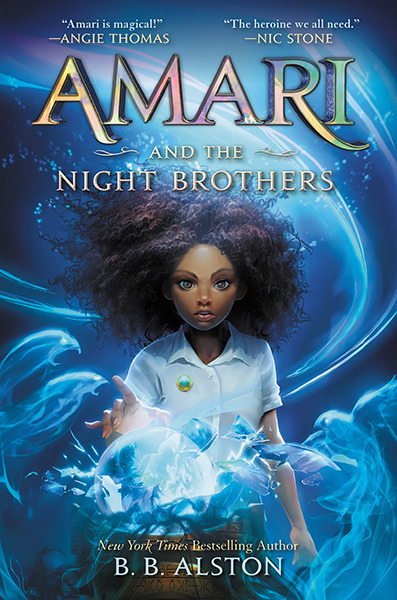Amari and the Night Brothers
Pitch by Piper Lynch
In B.B Alston’s novel, Amari Peters’ brother Quinton goes missing for months, leaving behind only a briefcase for his younger sister. Within this mysterious briefcase, he’s left her a nomination for a summer tryout at the secretive Bureau of Supernatural Affairs. Amari is thrust into the supernatural world and competes against the wealthiest kids for a Junior position in the bureau her brother used to occupy. Amari works to overcome the obstacles of not growing up in the magical world and hone her blossoming supernatural abilities.
Why does this book matter?
Amari Peters is a young Black girl from a low-income household who struggles against social and systemic injustices at a predominantly wealthy white institution. In an advanced reader's copy of the novel, the author B.B Alston discusses that white protagonists are the default middle-grade hero, and he remembers longing for main characters that looked like him as a child. Readers witness the microaggressions and systemic barriers of the natural world and the supernatural that affect Amari as a Black girl. Amari is bullied at her predominantly wealthy white high school in the regular world. In the supernatural world, she faces discrimination based on her race and class (discrimination grounded in reality), like being looked down upon due to her lack of wealth and education in the supernatural realm. Although Amari also faces discrimination based on her magical abilities, systemic oppression exists in the supernatural world (fantastical discrimination though not foreign in concept).
When asked about the themes of systemic oppression in an interview Alston says: “Amari is no stranger to being on the receiving end of negative stereotypes. And so I think when she encounters something similar in the supernatural world, it’s less jarring for her than it would be for someone who hadn’t had her life experiences. But Amari is still a human being, and there are times when it really does get to her. She gets frustrated and she lashes out. I think it’s in those moments that her individual character comes out. Having hope is a choice and it’s one that she continues to make.” (Alston)
Windows and mirrors
This book allows a mirror to be held up for Black readers getting to see the pressures of growing Black and themselves in the role of fantasy protagonist. It is also notable that non-black and/or wealthy children should see portrayals of systemic discrimination to understand the way hold privilege over others.
Sources
Alston, B. B., and Godwin Akpan. Amari and the Night Brothers. Balzer + Bray, an Imprint of HarperCollins Publishers, 2022.
Alston, B.B. “Review: Amari and the Night Brothers by B.B. Alston.” The Booktopian, https://www.booktopia.com.au/blog/2021/01/21/review-amari-and-the-night-brothers-by-b-b-alston/.
Brechner, Kenny, et al. Shelftalker, 11 Feb. 2021, https://blogs.publishersweekly.com/blogs/shelftalker/?p=33076.

